Diplomatic Bluebook 2018
Chapter 2
Japan's Foreign Policy that Takes a Panoramic Perspective of the World Map
2 China / Mongolia, etc.
(1)China
A The Situation in China
(A) Domestic affairs
In October, the 19th National Congress of the Communist Party of China (CPC) (Party Congress), held every five years, was held. The report on the 19th Party Congress described the “Xi Jinping thought on socialism with Chinese characteristics for a new era” as a guiding principle to “achieve the Chinese dream of great rejuvenation of the Chinese nation,” which was laid down in the party protocol. The report gave a summary of China's history since the founding of the nation, describing how it “stood up” under Mao Zedong, and “grow rich” under Deng Xiaoping, arriving at the current stage at which it “becomes strong.” The report described the setting of a new goal of developing the country into a modernized socialist country by 2035, and a great modern socialist country by the middle of this century. The CPC's new leadership was inaugurated after the Party Congress, and the Politburo Standing Committee of the CPC (the top seven members of the party) in order of ranking were named as Mr. Xi Jinping and Mr. Li Keqiang, who remained in office, followed by the newly appointed Mr. Li Zhanshu, Mr. Wang Yang, Mr. Wang Huning, Mr. Zhao Leji and Mr. Han Zheng. Mr. Xi Jinping was simultaneously reappointed as General Secretary and Chairman of the Central Military Commission. Many members of the Politburo of the CPC (top 25 members) are said to be close to Mr. Xi Jinping, resulting in his further consolidation of power.
China's anti-corruption crackdown which has been promoted since the birth of the Xi Jinping administration continued in 2017. Just prior to the 19th CPC National Congress, in July, Mr. Sun Zhengcai, who was the Chongqing Communist Party Secretary, touted to be one of the next-generation leaders, was placed under investigation for suspicion of “serious violations of the law,” and he was stripped of his title at the end of September. The 19th CPC National Congress reaffirmed the bolstering of governance in the party, and this trend has been continuing after the Party Congress.
Regarding social affairs, Mr. Liu Xiaobo, a Nobel Laureate who had been incarcerated for inciting subversion of state power, passed away in July. The Chinese authorities were criticized by the Governments and media of other countries for their treatment of Mr. Xiaobo and his family. The clampdown on activists and ethnic minorities by the authorities continues to be bolstered, and concerns are being aired in the international community for the situation of human rights in China.
In July, Hong Kong celebrated the 20th anniversary of its handover to China, and Ms. Carrie Lam was inaugurated as the first female and 4th Chief Executive of Hong Kong. The inauguration ceremony was attended by President Xi Jinping, who tried to subdue democracy advocates by stating, “any attempt to endanger national sovereignty and security, challenge the power of the central government... is an act that crosses the red line.” At the same time, he requested more patriotic education in the youth. It was reported that a major demonstration was held by democracy advocates who opposed the central government on the day of the ceremony.
(B) Economy
The economy in China has continued recovering, and the real GDP for 2017 increased 6.9% year-on-year, and total trade value increased 11.4% year-on-year. On the other hand, in the short term the business trends vary greatly among regions and industries. For example, in the secondary industries, the mining industry with excess production capacity is slowing down, while tertiary industries including the service industry has been growing steadily demonstrating an inconsistent pattern.
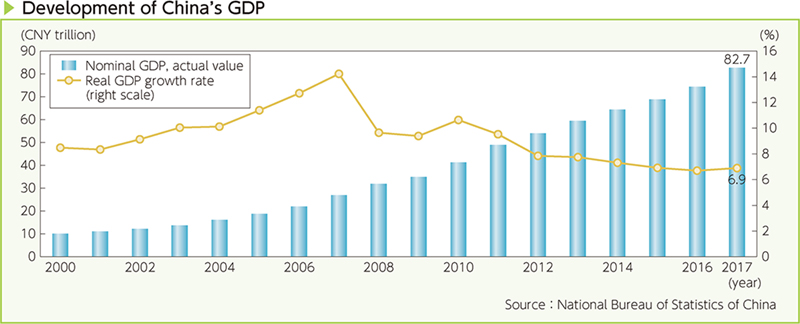
Looking at the financial trends, stocks on the Shanghai stock market remain stable at around 3,200 to 3,400 points. Moreover, the change in the way exchange rates are calculated in May 2017 led to a rise in the value of the yuan against the US dollar. However, after autumn, the easing of fears of capital outflow, which had continued since 2014, led to a drop in the value of the yuan against the US dollar, stabilizing at around 6.6 yuan to the US dollar.
As mentioned earlier, the policy of developing China into a great modern socialist country, becoming a global leader in terms of composite national strength and international influence and achieving common prosperity for everyone by the middle of this century, was laid down at the 19th CPC National Congress. As for economic policies, realizing high-quality economic growth by supply side reform and making China a country of innovators, and eliminating social disparity by raising incomes, strengthening the social security and withdrawing from poverty was delivered. Moreover, at the Central Economic Work Conference held in December, it was decided to firmly stick to the key policy of striving in pursuit of progress within stability, with 2018 being the first year in implementing the spirit of the 19th Party Congress. Achieving high-quality growth and eliminating social disparity requires long-term efforts with both the public and private sectors sharing the economic burden, and there is also expected to be opposition from parties with vested interests. On the other hand, the stable short-term operations of the party and administration require stable economic growth and domestic support. There will be a need to deal with the issues while balancing out these factors. Attention has been focusing on the economic and financial policies and trends in the specific actions taken by the new party leadership.
(C) Foreign Policy
In 2017, China engaged proactively in foreign diplomacy based on the “Belt and Road Initiatives” and 19th Party Congress. In May, Beijing hosted a high-level international cooperation forum, dubbed “One Belt, One Road,” which was attended by leaders from 29 countries. Moreover, in September, a BRICS Summit was held in Xiamen of Fujian Province, and then in November, a CPC in Dialogue with World Political Parties High-Level Meeting was held in Beijing for exchanging of opinions, attended by political party leaders from 120 countries throughout the world.
Regarding the U.S.-China relationship, the two countries agreed at the U.S.-China Summit Meeting held in April in the U.S. to hold comprehensive dialogues consisting of four cabinet-level dialogues. In November, President Trump paid a visit to China as a State Guest, and was given a warm reception, being invited to a dinner party at Gugong by President Xi Jinping. Business negotiations worth a total of 2.8 trillion yen were also concluded on the occasion.
On foreign policy in the future, it was decided at the 19th Party Congress that China would contribute more proactively to the forming of an international order based on the concept of building “a community with a shared future for mankind.”
(D) Military Affairs and Security
China has continued to increase defense expenditures at a high level. However, the breakdown of the budget and the intention behind the increase has not been disclosed sufficiently. Under such circumstances, its nuclear and missile capabilities and military power centered on naval and air forces have been enhanced extensively and rapidly. Such expansion of military capability lacking transparency, and unilateral actions to change the status quo in, e.g., the East China Sea, are common concerns in the region and international community.
On the other hand, in the field of nontraditional security, China has been demonstrating a cooperative and proactive stance, taking an active part in United Nations PKOs, providing various kinds of humanitarian aid and disaster support, etc., for which it has won high appraisal in the international community.
At the 19th Party Congress, President Xi Jinping stated that China would transform its armed forces into a world-class military by the middle of this century. In recent years, China has grown to have a great influence on the international community, not only politically and economically, but also militarily. To dispel any fears of China, there is a pressing need for China to increase transparency regarding its national defense policies and military power through specific and accurate disclosure of information. Japan intends to further promote mutual trust in Japan-China relations through dialogue and exchanges, including the Japan-China Security Dialogue, while cooperating with other countries concerned. Japan also intends to urge China to improve its transparency and encourage its positive involvement in the international order based on the rule of law.
B Japan-China Relationship
(A) Bilateral Relations - General
The relationship with China, the neighboring country across the East China Sea, is one of Japan's most important bilateral relationships, and the two countries have close economic relations, as well as people-to-people and cultural exchanges20. 2017 marked the 45th anniversary of the normalization of Japan-China diplomatic relations, and the opportunity was taken to hold high-level dialogues including Summit Meetings and Foreign Ministers' Meetings. It was a year in which momentum for improvement in Japan-China relations greatly increased.
China-Japan Foreign Ministers' Meetings were held in February (G20 Foreign Ministers' Meeting) and April (UN Security Council Meeting). State Councilor Yang Jiechi also visited Japan in May. At the G20 Hamburg Summit (Germany) in July, a Summit Meeting was held with President Xi Jinping, and it was reaffirmed that the two countries would further promote people-to-people exchanges and deepen cooperative ties in various economic fields in an effort to improve relations. Moreover, Japan-China Foreign Ministers' Meetings were held immediately after the inauguration of Foreign Minister Kono, in August (ASEAN-related Foreign Ministers' Meeting) and September (UN General Assembly), where opinions were exchanged on how Japan-China relations could be improved, and on the North Korea issue. As relationships of trust between the leaders and Foreign Ministers improve through active dialogue, a reception was held in Tokyo on September 28 to celebrate the 45th anniversary of the normalization of diplomatic relations with China organized by the Chinese Embassy. There, Prime Minister Abe stated the need of realizing leaders' mutual visits that consist of Premier Li Keqiang's visit to Japan on the occasion of the Japan-China-ROK Trilateral Summit, Prime Minister Abe's visit to China and President Xi Jinping's subsequent visit to Japan, indicating a path toward further improvement in Japan-China relations. On September 29, the anniversary of the normalization of diplomatic relations with China, congratulatory telegrams were exchanged between Prime Minister Abe and Premier Li Keqiang, and Foreign Minister Kono and Foreign Minister Wang Yi. The APEC Summit Meeting (Da Nang, Viet Nam) and the ASEAN-related Summit Meeting (Manila, the Philippines) in November provided opportunities to hold Japan-China Summit Meetings with President Xi Jinping and Premier Li Keqiang, where there were exchanges of forward-looking opinions regarding the leaders' mutual visits, promoting people-to-people exchanges, bolstering of economic ties, etc., to mark the 40th anniversary of the conclusion of the Treaty of Peace and Friendship between Japan and China, in 2018. The meetings marked the start of renewed efforts for a total improvement in relations. With the frequent holding of high-level dialogues, steady progress has been made by the two Governments toward the holding of practical dialogue and the cultivation of trust between Japan and China, including talks between the diplomatic authorities in April, the Japan-China High-Level Consultation on Maritime Affairs in June and December, and the Japan-China Security Dialogue in October.
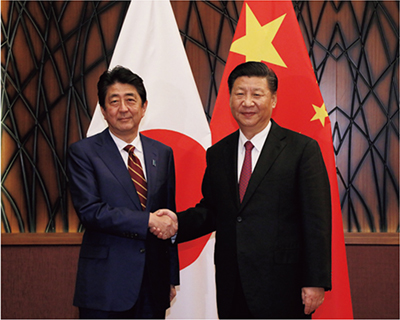 Japan-China Summit Meeting with President Xi Jinping (November 11, Da Nang, Viet Nam; Photo: Cabinet Public Relations Office)
Japan-China Summit Meeting with President Xi Jinping (November 11, Da Nang, Viet Nam; Photo: Cabinet Public Relations Office)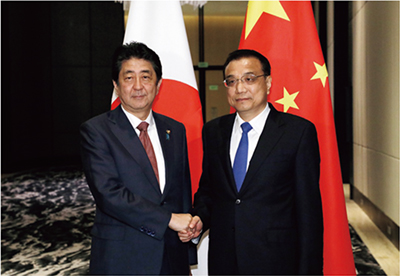 Japan-China Summit Meeting with Premier Li Keqiang (November 13, Manila, the Philippines; Photo: Cabinet Public Relations Office)
Japan-China Summit Meeting with Premier Li Keqiang (November 13, Manila, the Philippines; Photo: Cabinet Public Relations Office)Both Japan and China share a major responsibility for the peace and stability of the region and the international community, and a stable relationship between Japan and China is essential not only to the citizens of both countries but also to, e.g., dealing with regional and international issues, including the North Korean issue. Founded on the idea of building “a Mutually Beneficial Relationship based on Common Strategic Interests” in which it is important to develop the relations of the two countries by expanding their common interests in the context of contributing together to the international community, the Japanese Government will continue to promote a friendly relationship with China from a broad perspective through continued dialogues and cooperation at various levels.
- 20 Since 1979, Japan has extended Official Development Assistance (ODA) of a cumulative total of more than three trillion yen to China. Approximately ten years ago, however, Japan terminated implementing new projects under Loan Aid and General Grant Aid, which had accounted for a large share of Japan's ODA to China, recognizing that ODA had already achieved a certain role in light of the economic development and improved technology level of China. Currently, ODA projects have been implemented to a limited degree in areas in which strict necessity for cooperation is acknowledged. Such areas include cross-border pollution, infectious diseases, and food safety, which directly affect the lives of the Japanese people. Technical Cooperation is the main form of cooperation (disbursements of 500 million yen in FY2016), while Grant Assistance for Grass-Roots Human Security Projects have also been implemented (disbursements of 29 million yen in FY2016). Furthermore, recently Japan has been proceeding with a new form of cooperation, in which China bears part of the costs.
(B) Japan-China Economic Relations
Economic relations between Japan and China, including trade and investment, are close and interdependent. The total trade between Japan and China (excluding Hong Kong) amounted to about 296.8 billion US dollars in 2017 (9.8% increase year-on-year), and China has been the largest trading partner for Japan for 12 consecutive years. Moreover, according to Chinese statistics, Japan's direct investment in China increased to about 3.27 billion US dollars (5.1% increase year-on-year (estimated from officially published information on investment)) in 2017, due to a continued trend of recovery in the Chinese economy. By country, Japan ranks third in terms of the amount of direct investment to China (Singapore ranks first, the ROK is second, and the U.S. is fourth).
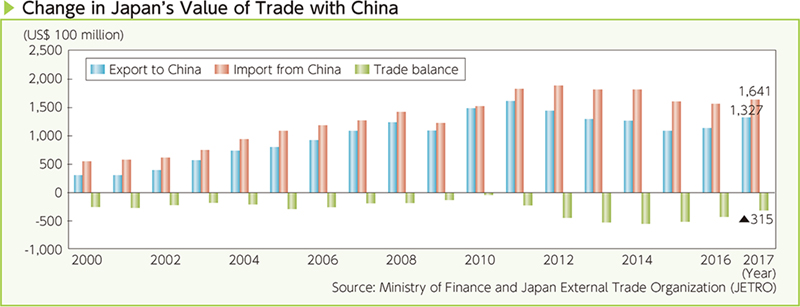
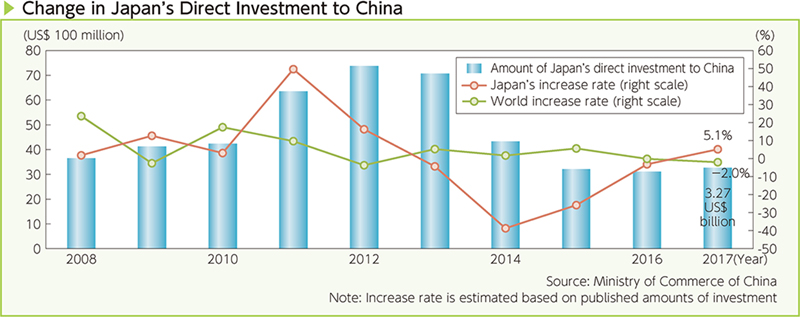
In 2017, the necessity for dialogue and cooperation between Japan and China in the economic area was reaffirmed through active dialogue at the summit and foreign minister levels. At the Summit Meeting during the G20 Hamburg Summit (Germany) in July, the two countries agreed to further promote economic cooperation, and bolster cooperation in various fields including finance, tourism, trade, environment and energy-savings. The countries also agreed to hold discussions on how they can contribute to stability and prosperity in the region and throughout the world, including the “Belt and Road Initiatives” proposed by China. These matters were discussed at the Japan-China Summit Meetings held during the APEC Summit Meeting (Da Nang, Viet Nam) and the ASEAN-related Summit Meeting (Manila, the Philippines) in November, in addition to agreeing that promoting businesses in the private sector, and expanding them into third countries would not only benefit Japan and China, but it would also be beneficial to the growth of those third countries.
In response to these developments, a range of active dialogue and exchanges were held in the economic field. To attend the opening event for the “Project to Support the Overseas Promotion of Regional Charms,” Deputy Chief Cabinet Secretary Kotaro Nogami visited China in February. In May, Finance Minister Xiao Jie visited Japan for a Japan-China Finance Dialogue, followed by Minister of Science and Technology Wan Gang in July, who held meetings with Minister of State for Science and Technology Policy Yosuke Tsuruho and Minister of Education, Culture, Sports, Science and Technology Hirokazu Matsuno. Minister of Agriculture, Forestry and Fisheries Yuji Yamamoto also visited China in July to meet Minister of General Administration of Quality Supervision, Inspection and Quarantine Zhi Shuping, and Vice Minister for the Ministry of Agriculture and Rural Affairs Yu Xinrong. Then in August, Minister of Agriculture, Forestry and Fisheries Ken Saito attended a food expo in Hong Kong. The Japan-China Economic Partnership Consultation in which high-ranking officials of relevant ministries and agencies get together from the two countries was held in November (Beijing, China), and wide-ranging views were exchanged on Japan-China bilateral issues and cooperation, as well as on regional and multilateral issues and cooperation. Furthermore, regarding the import restrictions placed on food and agricultural products from Japan by the Government of China, Japan has taken every opportunity, particularly the Japan-China Economic Partnership Consultation held in November, to urge the Chinese side to carry out an evaluation based on scientific evidence, and has lobbied for the abolition and relaxation of the restrictions.
Economic exchanges at the private sector level were also carried out actively. In November, the Japan-China Economic Association, Keidanren (Japan Business Federation) and Japan Chamber of Commerce and Industry jointly dispatched a delegation to China to hold a meeting with top officials from the Government of China, including Premier Li Keqiang. At a summit of CEOs, etc., from Japan and China held in Japan in December, views were exchanged between the executives of major companies in Japan and China, and the reception was also attended by Prime Minister Abe and Foreign Minister Kono.
On the working-level, various dialogues took place, including Japan-China governmental negotiations for Agreement on Social Security (April in Beijing and October in Tokyo).
(C) Promotion of Mutual Understanding Between Japanese and Chinese People
(Current situation of people-to-people exchanges between Japan and China)
The number of Chinese visitors to Japan has continued to increase since 2013. The number of visitors in 2017 reached around 7.36 million people (estimated by JNTO), with a 15.4% increase year-on-year. This marked a decline in the rate of increase, but set a new record in terms of the number of visitors. There was a further shift from group tourism to individual tourism, and there was also an increase in the number of repeat visitors as a result of relaxed visa requirements. It is thought that this is leading to diversification of the destinations and needs of visitors to Japan.
(Japan-China youth exchange, etc.)
In 2017, Japan invited around 1,600 Chinese high school students and young adults under the program, “JENESYS (Japan-East Asia Network of Exchange for Students and Youths) 2.0.” and “JENESYS 2017.” Young Chinese people who visited Japan experienced various cultures, lifestyles and the charms of Japan through school exchanges and tours of companies, while deepening mutual understanding with Japanese youth. They also actively exchanged opinions about what the future of Japan-China relations should be. Furthermore, under the Japan-China International Solidarity Project on Afforestation and Tree-Planting21, a thousand or so people were invited to the exchange event for promoting understanding of Japan based on the theme of the “Three KAKEHASHI (Bridge) Projects ((1) Regional exchanges (2) Youth exchanges, and (3) Culture and sports exchanges)”
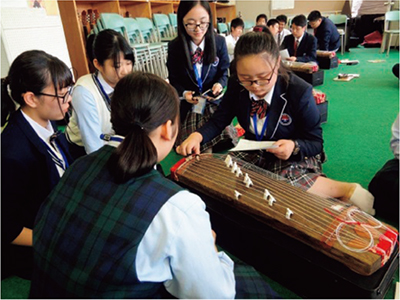 A group of Chinese high school students visit Japan for exchanges. Exchange upon visiting Towanomori Sanai High School affiliated to Rakuno Gakuen University (September 11, Hokkaido; Photo: Japan-China Friendship Center)
A group of Chinese high school students visit Japan for exchanges. Exchange upon visiting Towanomori Sanai High School affiliated to Rakuno Gakuen University (September 11, Hokkaido; Photo: Japan-China Friendship Center)- 21 Size of budget: 9 billion yen (FY2015 supplementary budget)
(Exchanges in various fields)
To develop Japan-China stable relations that will continue in the future, the Government of Japan endeavors to invite people at various levels in all walks of life to Japan, such as leaders of central and local governments in China, people who have certain influence in the political, economic, public and academic sectors, and next-generation leaders and opinion leaders, in addition to young people who will carry the next generation, such as high school students and university students, thereby making efforts for a wide range of relationship building and strengthening. Through exchanges including the exchanging of views with various circles and experts in Japan, and inspection tours, it is expected that good relationships will be built between the participants, promoting a more accurate understanding of Japan.
Furthermore, in 2017 which is the 45th anniversary of the normalization of Japan-China diplomatic relations, 370 approved events were held including a variety of cultural exchange programs, promoting the building of friendly relations.
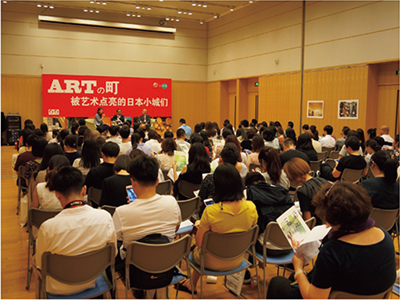 Japan City of Art PR Seminar (August 18, The Embassy of Japan in China, China)
Japan City of Art PR Seminar (August 18, The Embassy of Japan in China, China)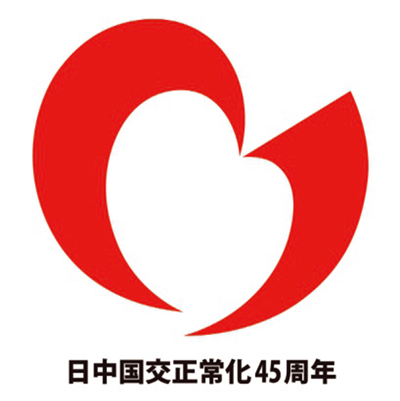 Logo
LogoForty-five years ago, on September 29, 1972, Prime Minister Kakuei Tanaka signed the Joint Communique of the Government of Japan and the Government of the People's Republic of China with Premier of the State Council Zhou En-lai in Beijing, thus realizing the normalization of diplomatic relations between Japan and China. From then on, the relationship between Japan and China, countries that have a history of exchange extending for more than 2,000 years, entered a new era. Since then, the relationship between the two countries has progressed steadily, and today, broad exchanges are being made between the people of the two countries. In 2017, in commemoration of the 45th anniversary of the normalization of diplomatic relations, various events were held to further promote exchanges and cooperation between Japan and China.
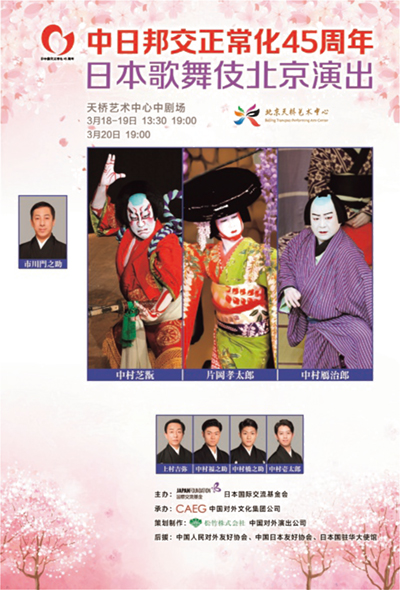 Poster for the Shochiku Grand Kabuki performances in Beijing
Poster for the Shochiku Grand Kabuki performances in Beijing©Shochiku
In March, performances of the Shochiku Grand Kabuki were held in Beijing by the Japan Foundation, and the tickets sold out immediately after going on sale. The program featured performances of “Yoshitsune and the Thousand Cherry Trees,” “The Love Messenger of Yamato,” and “Wisteria Maiden,” which are also popular in Japan, and simultaneous commentary through headphones in Chinese was also provided. Shouts of joy rang out during the shows' climaxes, and the performances served as a perfect opportunity for the audience to get familiar with traditional Japanese culture.
In June, the Japan-China Green Expo was held in Beijing for the first time in six years, in order to promote cooperation in the field of environment. The Expo was jointly hosted by business organizations from Japan and China, and approximately 40 Japanese companies participated. The environment is a field in which Japan and China, as two of the world's largest economies, should work cooperatively, and the Expo is expected to be a precursor for cooperation on various global issues.
On September 8 at the Great Hall of the People in Beijing, and on September 28 in Tokyo, receptions were held to celebrate the 45th anniversary of the normalization of diplomatic relations between Japan and China, and the latter event was attended by Prime Minister Abe and Foreign Minister Kono among others. Furthermore, on September 29 on the anniversary of the normalization of diplomatic relations, congratulatory telegrams were exchanged between Prime Minister Abe and Premier of the State Council Li Keqiang, and Foreign Minister Kono and Foreign Minister Wang Yi respectively. The two sides exchanged positive messages on advancing the Japan-China relationship.
In addition, in the field of sports, the “Japan-China Friendship Cities' Junior high School Students Table Tennis Exchange Tournament” was jointly held in Beijing in August by friendship organizations in both China and Japan, and junior high school students from both countries attended. In the field of film, an agreement in principle on the Film Co-Production Agreement between Japan and China was announced at the Tokyo International Film Festival in October. Exchanges and cooperation between Japan and China are moving ahead in a broad range of fields.
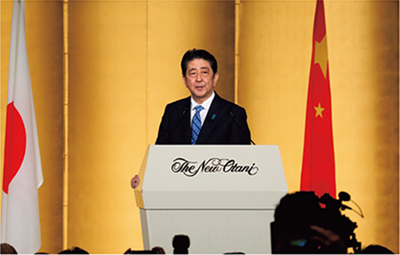 Prime Minister Abe making remarks at the reception to celebrate the 45th anniversary of the normalization of diplomatic relations between Japan and China (September 28, Tokyo; Photo: Cabinet Public Relations Office)
Prime Minister Abe making remarks at the reception to celebrate the 45th anniversary of the normalization of diplomatic relations between Japan and China (September 28, Tokyo; Photo: Cabinet Public Relations Office)Japan and China are important partners in Asia that are located next to one another across the East China Sea. In order to advance the two countries' amicable and cooperative relationship stably, it is essential to deepen exchanges and dialogue in various fields and at various levels, including in areas such as youth exchanges, culture, film, tourism, sports, economy and inter-regional exchanges. In 2018, taking the opportunity of the 40th anniversary of the conclusion of the Treaty of Peace and Friendship between Japan and the People's Republic of China, Japan and China will also continue to work cooperatively to develop the relationship under the concept of “Mutually Beneficial Relationship Based on Common Strategic Interests.”
(D) Dealing Appropriately with Pending Issues
(Situation surrounding the East China Sea)
In the East China Sea, Chinese Government-owned vessels continue to intrude into Japanese territorial waters around the Senkaku Islands. Also, the Chinese military has been rapidly expanding and increasing its activities in quality and quantity in the area. Furthermore, China continues unilateral development of resources in the maritime area pending delimitation between Japan and China, and has repeatedly carried out maritime surveys without Japan's consent.
The Senkaku Islands are indisputably an inherent part of the territory of Japan in light of historical facts and based upon international law. Indeed, the Senkaku Islands are under the valid control of Japan. Thus, there exists no issue of territorial sovereignty to be resolved concerning the Senkaku Islands. From 1895, when Japan obtained territorial title over the Senkaku Islands by lawful means under international law, until the 1970s, when the islands became the focus of attention after it was suggested that there might be oil reserves in the East China Sea, China had not raised any objections to Japan's sovereignty over the Senkaku Islands. Moreover, China has never explained why it had not expressed objections until then.
Regarding trends in the presence of Chinese Government-owned vessels and fishing boats in the waters around the Senkaku Islands, no incidents occurred in 2017 similar to the incident in August 2016, when huge numbers of Chinese Government-owned vessels and fishing boats gathered around the islands. However, Chinese Government-owned vessels continue to intrude into Japanese territorial waters, recording 29 incidents a year (the numbers were 36 in 2016, and 35 in 2015). In response to such unilateral attempts by China to change the status quo, the Government of Japan has repeatedly lodged strong protests and requested the withdrawal of Chinese vessels. To defend Japan's territorial land, sea and airspace, Japan will deal with the situation with resolute and calm determination.
Chinese naval vessels and aircraft have also been accelerating their activities in the sea and airspace around Japan. Aircraft activity in particular is on the increase, and since the 19th Party Congress, the frequency of flights over international waters between Okinawa Island and Miyako Island has increased. Then in December, a Chinese fighter plane flew over international waters in the Tsushima Channel for the first time. Under these circumstances, a new record was set in the number of times the Air Self-Defense Force had to scramble jets in FY2016 in response to Chinese military aircraft. In response to these recent activities by the Chinese military, Japan has been raising the issues in an appropriate manner through diplomatic routes.
Furthermore, in recent years, China has accelerated its activities to develop natural resources in the East China Sea. The Government of Japan has confirmed 12 new structures built between June 2013 and May 2016, making a total of 16 structures including those confirmed before then, on the Chinese side of the geographical equidistance line. The Exclusive Economic Zone and the continental shelf in the East China Sea have not yet been delimited, and it is extremely regrettable that China is advancing unilateral resource development. Every time such moves by China are recognized, Japan has strongly requested China to cease its unilateral development and to resume negotiations as soon as possible on the implementation of the “June 2008 Agreement” regarding the cooperation between Japan and China on the development of natural resources in the East China Sea.
Moreover, in recent years numerous activities by China to carry out surveys in the waters around Japan, including the East China Sea, without obtaining Japan's approval, or surveys that differ from those agreed upon have been confirmed.
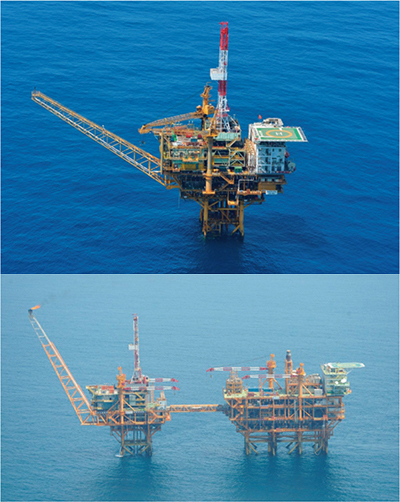 A Chinese maritime platform confirmed to have been built near the geographical equidistant line between Japan and China (Photo: Ministry of Defense)
A Chinese maritime platform confirmed to have been built near the geographical equidistant line between Japan and China (Photo: Ministry of Defense)See the link below for details; http://www.mofa.go.jp/a_o/c_m1/page3e_000356.html
In order to deal with these concerns appropriately, both Japan and China have been promoting dialogue and exchanges between the authorities concerned. Japan-China High-Level Consultation on Maritime Affairs Round Meetings were held in June and December, in Fukuoka and Shanghai. At the meeting in December, Japan and China agreed to bolster communication regarding the “June 2008 Agreement,” and positive progress was made in the building and operation of a “Maritime and Air Communication mechanism between Japan-China defense authorities” to avoid unexpected situations. Furthermore, in October, the Japan-China Security Dialogue was held in Tokyo, and opinions were exchanged on cooperation, exchanges, etc., in the field of security.
As Prime Minister Abe stated at the Japan-China Summit Meeting during the APEC Summit Meeting (Da Nang, Viet Nam) in November, true improvement in Japan-China relations cannot be achieved without stability in the East China Sea. It is highly meaningful from the perspective of building trust and bolstering cooperation for diplomats from both countries to meet in person and exchange opinions frankly, such as at the Japan-China High-Level Consultation on Maritime Affairs Round Meetings, or the Japan-China Security Dialogue. The Government of Japan will strive to improve relations with China, while asserting Japan's position on individual issues through steady dialogue and continued bolstering of communication, in an effort to turn the East China Sea into the ”Sea of Peace, Cooperation and Friendship.”
(Abandoned chemical weapons issue)
The Government of Japan, pursuant to the Chemical Weapons Convention (CWC), has been working on the disposal of chemical weapons which were abandoned by the Imperial Japanese Army in China. In 2017, a survey was carried out on the status of chemical weapons in various regions around China. Weapons were excavated and recovered, and test disposal took place in Haerbaling District in Dunhua, Jilin Province. The disposal of a cumulative total of about 50,000 abandoned chemical weapons has been completed (as of December 2017).
(2) Taiwan
A Internal Affairs
The Tsai Ing-wen administration has entered its second year, passing a pension reform bill to change the favorable treatment of public officials and teachers in successfully dealing with internal affairs. However, her popularity has dropped, and the Premier was replaced in September.
On the economic front, the real GDP growth rate in 2017 increased by 2.86% (calculated from estimates) year-on-year due to foreign demand and steady private consumption.
B Cross-strait Relations and Foreign Affairs
Since the inauguration of the Tsai Ing-wen administration, exchanges and communications by the liaison institutions in both China and Taiwan (the Association for Relations Across the Taiwan Strait, and the Straits Exchange Foundation) have been discontinued, and the number of tourists from China to Taiwan has decreased. Moreover, Taiwan was unable to attend numerous meetings held by international organizations, including the World Health Organization (WHO), due to opposition from China. In June, Panama established diplomatic relations with China, decreasing the number of countries with diplomatic ties with Taiwan to 20.
C Japan-Taiwan Relationship
For Japan, Taiwan is a crucial partner and an important friend, with which it shares fundamental values such as freedom, democracy, basic human rights, and the rule of law, and enjoys close economic relations and people-to-people exchanges. The relationship between Japan and Taiwan is maintained on the basis of working relations at the non-governmental level in accordance with the 1972 Joint Communiqué between Japan and China. In November, cooperation documents regarding (1) mutual assistance in custom matters and (2) cultural exchanges between the Japan-Taiwan Exchange Association and the Taiwan-Japan Relations Association were signed. Then the 2nd dialogue on maritime cooperation was held in December, resulting in the signing of a cooperation document on maritime search and rescue cooperation.
In September, Taiwan lifted the ban on imports of Japanese beef for the first time in 16 years. On the other hand, Taiwan has continued to impose import restrictions on Japanese food products after the Great East Japan Earthquake, and Japan has repeatedly requested the removal and relaxation of the restrictions.
(3) Mongolia
A Domestic Affairs
In the presidential election held in June (direct election with a four-year term of office), none of the three candidates could acquire the majority of votes, and after a runoff election between the top two candidates held for the first time in the history of Mongolia, the opposition Democratic Party candidate, Mr. Battulga, won and was inaugurated as President in July.
On the other hand, there was a confrontation within the ruling People's Party as the result of its candidate, Chairman of State Great Hural (Parliament) Enkhbold, losing the election, and the Erdenebat Cabinet, inaugurated in July 2016, stepped down in September. In October, former Deputy Prime Minister Khurelsukh, was appointed as the new Prime Minister, and in November, he was chosen as the leader of the People's Party.
The Khurelsukh Cabinet prioritizes the consistency and continuity of policies. In particular, it aims to achieve the economic and fiscal reconstruction of Mongolia through steady implementing of the Extended Fund Facility (EFF) agreed upon with the International Monetary Fund (IMF).
B Japan-Mongolia Relations
Mongolia is an important regional partner sharing fundamental values with Japan, so Japan will continue to strengthen friendly ties with the country in a “Strategic Partnership,” so that the relationship will truly be mutually beneficial.
2017 marked the 45th anniversary of the establishment of Japan-Mongolia diplomatic relations, and a variety of memorial events were held in both countries.
The Governments of the two countries engaged in active dialogue, holding the 2nd Japan-Mongolia Strategic Dialogue in February (Ulaanbaatar, Mongolia), a Foreign Ministers' Meeting in March (Tokyo), the 4th Japan-Mongolia Diplomatic Defense and Security Coordination Meeting in August (Ulaanbaatar, Mongolia), and a Summit Meeting in September (Vladivostok, Russia). Moreover, the 2nd Japan-U.S.-Mongolia Trilateral Dialogue was held in August (Ulaanbaatar, Mongolia).
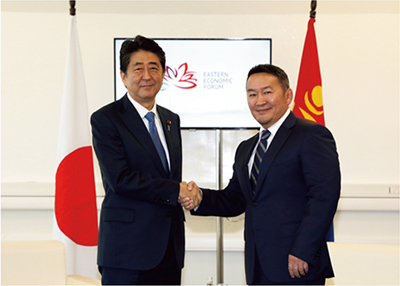 Japan-Mongolia Summit Meeting with President Battulga (September 6, Ulaanbaatar, Mongolia; Photo: Cabinet Public Relations Office)
Japan-Mongolia Summit Meeting with President Battulga (September 6, Ulaanbaatar, Mongolia; Photo: Cabinet Public Relations Office)After Chairman of State Great Hural (Parliament) Enkhbold's visit to Japan in March, Speaker of the House of Representatives Oshima visited Mongolia for the first time in July as an incumbent Speaker of the House of Representatives. Furthermore, in September, the Japan-Mongolia Friendship Parliamentarian's Union (Leader: Speaker of the House of Representatives Motoo Hayashi (Chairman)) visited Mongolia, resulting in the further bolstering of bilateral ties through extensive exchanges.
 Both Foreign Ministers signed the Japan-Mongolia Mid-term Action Plan for a Strategic Partnership witnessed by Chairman of State Great Khural (Parliament) Enkhbold (March 29, Ministry of Foreign Affairs, Tokyo)
Both Foreign Ministers signed the Japan-Mongolia Mid-term Action Plan for a Strategic Partnership witnessed by Chairman of State Great Khural (Parliament) Enkhbold (March 29, Ministry of Foreign Affairs, Tokyo)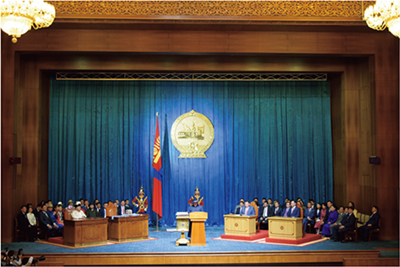 Ceremony to commemorate the inauguration of President Battulga (July 10, Ulaanbaatar, Mongolia)
Ceremony to commemorate the inauguration of President Battulga (July 10, Ulaanbaatar, Mongolia)Other than that, the Japan-Mongolia Mid-term Action Plan for a Strategic Partnership (2017–2021) was signed by the Foreign Ministers of both countries in March as a specific policy on cooperation, and as part of an international assistance package formulated by the International Monetary Fund (IMF), it was decided that Japan would provide financial support to Mongolia of up to 850 million US dollars over three years, and the first disbursement (32 billion yen) was made in December. Moreover, in November, it was decided that a grant aid (around 2.4 billion yen) would be provided to build or expand four model schools for children with disabilities, or for use in disaster prevention, using Japanese knowledge.

